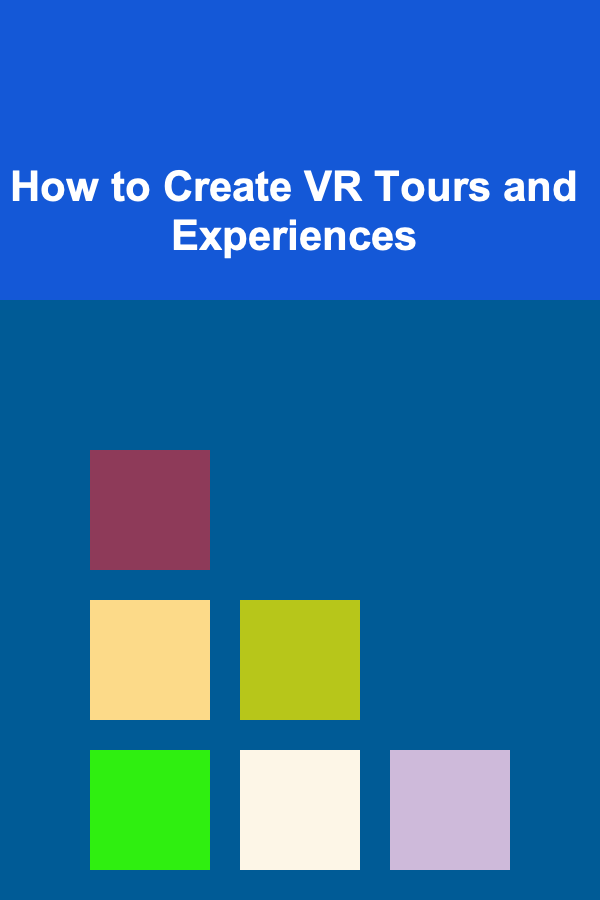
How to Create VR Tours and Experiences
ebook include PDF & Audio bundle (Micro Guide)
$12.99$7.99
Limited Time Offer! Order within the next:

Virtual Reality (VR) has evolved rapidly over the last decade, transforming from a niche technology to a mainstream tool with countless applications. One of the most fascinating and immersive uses of VR is in creating virtual tours and experiences, which allow users to explore environments in an interactive way. Whether it's a virtual museum, a property tour, or an immersive travel experience, VR can transport users to places they may never physically visit, all from the comfort of their own home.
In this article, we'll explore the steps, tools, and techniques involved in creating effective and immersive VR tours and experiences. We'll cover everything from planning and design to the technology and software tools you'll need. By the end of this guide, you should have a solid understanding of how to create VR content that can captivate and engage users.
Understanding VR Tours and Experiences
Before diving into the creation process, it's important to understand what makes a successful VR tour or experience. A VR tour is an interactive simulation of a real-world location, like a museum, city, or property, while VR experiences can include anything from exploring fictional worlds to simulations that teach a particular skill or knowledge.
Unlike traditional videos or images, VR allows the user to immerse themselves in the environment, offering a sense of presence and interactivity. The key to a successful VR tour or experience is its ability to engage users by providing a realistic and engaging simulation of a place or event.
Types of VR Tours and Experiences
- 360° Virtual Tours: These tours allow users to look around a scene, often created from a 360° camera or software-based rendering.
- Interactive VR Experiences: These are more immersive, where users can actively interact with objects and navigate through different spaces in a digital world.
- Mixed Reality: Combining elements of real-world environments with virtual objects, allowing for interactions between physical and virtual elements.
- Game-like VR: For educational or entertainment purposes, these can turn a virtual tour into an interactive experience.
Key Steps in Creating VR Tours
Creating a VR tour involves several key stages, from conceptualization to final execution. Here's an outline of the process:
Step 1: Define Your Objective
The first step in creating any VR experience is to define your goal. What kind of VR tour are you looking to create? Are you promoting a destination, showing off a real estate property, or giving users a virtual glimpse of a museum? Identifying the purpose and target audience of your VR experience will guide all your design and content decisions.
For instance, if you're creating a VR tour for a real estate listing, your focus will be on highlighting the space, giving users the ability to explore rooms, view different angles, and possibly even customize the decor. If you're creating a museum tour, your goal might be to educate and inform users about the exhibits, requiring you to focus on interactivity and informative content.
Step 2: Choose Your VR Platform
Decide which platform you want to develop your VR experience for. There are several different VR platforms, each with its own set of requirements and best practices. Some popular VR platforms include:
- Oculus Rift/Quest: A highly popular platform with high-quality VR hardware.
- HTC Vive: Known for offering a more robust and high-end VR experience.
- PlayStation VR: A good option if you're targeting the console gaming audience.
- WebVR: A browser-based VR that allows for VR experiences without needing additional hardware (though it's not as immersive as other platforms).
- Mobile VR: Platforms like Google Cardboard or Samsung Gear VR allow for VR on smartphones.
Each platform has different technical requirements and limitations, so it's essential to keep that in mind when designing your VR tour.
Step 3: Capture or Create 3D Content
Now comes the fun part: capturing or creating the content that will form the core of your VR tour. There are two main approaches here:
1. 360° Photography and Video:
- 360° Cameras: These specialized cameras capture an entire scene in all directions simultaneously, giving users the ability to look around in any direction. Popular models include the GoPro Max, Ricoh Theta Z1, and the Insta360 One X2.
- 360° Video: To create a fully immersive experience, 360° video lets users experience real-world locations or events from a first-person perspective. The video should be recorded at a high resolution (4K or above) to ensure a crisp and clear image.
2. 3D Models:
- If your VR experience involves interactive environments (e.g., virtual tours of a property), creating 3D models will be necessary. 3D modeling software like Blender , Autodesk Maya , or Unity can help you build virtual environments.
- 3D models can range from simple objects to complex, photorealistic landscapes or buildings. These models allow users to explore the space interactively, either by walking through it or selecting different areas to view.
Step 4: Develop the User Interface and Interactivity
For an interactive VR experience, you'll need to think about how users will navigate the environment and interact with objects. Here's what you need to consider:
- Navigation: How will users move through the virtual space? In some experiences, users can simply look around, but in others, they'll need a way to move from one point to another. You might want to implement a teleportation system, where users point to a location and instantly transport there, or use a joystick or controller for movement.
- User Interface (UI): How will users interact with the content? For a real estate tour, for instance, you might include interactive hotspots that provide additional information when clicked. For a museum tour, you might want to include informational pop-ups or audio guides triggered when the user focuses on an exhibit.
- Audio: Sound plays a crucial role in enhancing immersion. Use 3D audio to make sure sounds come from the correct direction based on the user's viewpoint. This is especially important for virtual tours of places like museums, historical sites, or nature reserves.
Step 5: Add Information and Enhancements
This is where you can get creative. Depending on the type of VR tour you're creating, you might want to include the following:
- Text Overlays: Information about the locations or objects in the scene can appear when the user focuses on certain elements. For example, when users look at a painting in a virtual museum tour, they could see a brief description of the artwork.
- Audio Narration: Voiceovers or guided tours add a personal touch and can help guide the user through the experience. Ensure that the narration is synchronized with the user's viewpoint to create a natural flow.
- Animations: For some experiences, you may want to animate certain objects or environments. This can include objects moving in the scene, characters walking around, or elements of the environment changing in real-time.
- Gamification: For a more engaging experience, you might add interactive elements such as quizzes, achievements, or challenges that encourage users to explore more deeply.
Step 6: Testing and Optimization
Before launching your VR tour or experience, it's important to thoroughly test it. This process should involve:
- Usability Testing: Get feedback from users on how easy it is to navigate and interact with your VR environment. Check if there are any bugs or glitches that need fixing.
- Performance Testing: Ensure that your VR experience runs smoothly on your target platform. VR experiences can be demanding on hardware, so performance optimization is crucial to avoid lag or discomfort for users.
- User Comfort: VR can sometimes cause motion sickness, especially if the user is moving quickly or if there are sudden camera movements. Test for comfort and make adjustments to improve the user experience.
Step 7: Deployment and Distribution
Once your VR experience is complete and optimized, it's time to deploy it. Depending on the platform you're targeting, there are different ways to distribute your VR tour:
- App Stores: For mobile and standalone VR platforms like Oculus Quest, you can submit your VR experience to the respective app store.
- WebVR: If you're creating a web-based VR experience, you can host it on your own website or a VR content distribution platform.
- Direct Sharing: If you want to share your VR experience with a specific group, consider providing direct downloads or sharing links to the experience via email or social media.
Tools and Software for Creating VR Tours
Several tools can help streamline the process of creating VR tours and experiences. Here are some popular ones:
- Unity: A powerful game engine that supports VR development. Unity allows for the creation of both 3D environments and interactive content.
- Unreal Engine: Another advanced game engine, offering high-quality visuals and an easy-to-use interface for VR development.
- Blender: A free and open-source 3D creation suite, useful for creating 3D models and environments.
- Pano2VR: A tool designed specifically for creating 360° virtual tours. It allows you to easily convert panoramic photos or videos into immersive virtual tours.
- Google Tour Creator: A simple tool for creating 360° virtual tours. While less feature-rich than some other tools, it's perfect for beginners and quick projects.
Conclusion
Creating VR tours and experiences is an exciting and rewarding process that requires both creative vision and technical know-how. Whether you're building a virtual museum tour, showcasing a property, or developing an interactive experience, the key is to create something that immerses users and keeps them engaged. With the right planning, tools, and attention to detail, your VR experiences can offer users a powerful way to explore new places and ideas.
By following the steps outlined in this guide, you'll be well on your way to creating a memorable VR tour that captivates users and enhances their virtual experiences. Happy creating!
Reading More From Our Other Websites
- [Home Pet Care 101] How to Create a Comfortable and Safe Space for Your Pet at Night
- [Home Budget 101] How to Stick to Your Home Budget While Dealing with Unexpected Expenses
- [Metal Stamping Tip 101] Top 7 Common Defects in Metal Stamping and Proven Strategies to Eliminate Them
- [Tiny Home Living Tip 101] Best Creative Lighting Solutions for Ambiance and Functionality in Tiny Homes
- [Home Budget Decorating 101] How to Choose Affordable Art That Elevates Your Decor
- [Organization Tip 101] How to Create a Drawer for Kitchen Cleaning Supplies
- [Home Pet Care 101] How to Travel with Your Pet Safely and Comfortably: A Complete Guide for Cars, Planes, and Beyond
- [Organization Tip 101] How to Organize Tools and Equipment for Your Hobby
- [Home Rental Property 101] How to Handle Maintenance Requests from Tenants Efficiently
- [Survival Kit 101] Best Survival Kit for Ski Instructors Facing Sudden Snowstorms on Slopes

How to Create a Budget That Works for Your Lifestyle
Read More
How to Establish a Work-Life Balance in Your Home Office
Read More
How to Organize Your Bathroom Products for Easy Access
Read More
How to Save Money on Your Monthly Grocery Bill
Read More
Leveraging Blockchain for Data Privacy: A Deep Dive
Read More
How to Ferment Grains: Teff, Quinoa, and Ancient Varieties
Read MoreOther Products

How to Create a Budget That Works for Your Lifestyle
Read More
How to Establish a Work-Life Balance in Your Home Office
Read More
How to Organize Your Bathroom Products for Easy Access
Read More
How to Save Money on Your Monthly Grocery Bill
Read More
Leveraging Blockchain for Data Privacy: A Deep Dive
Read More